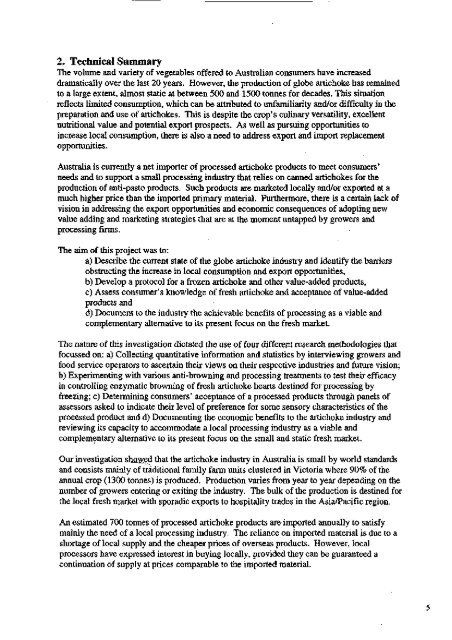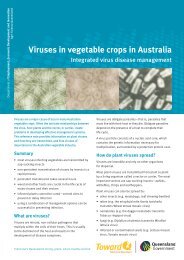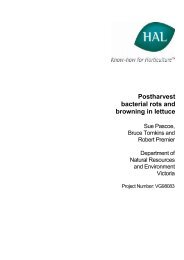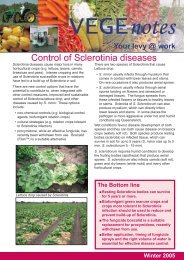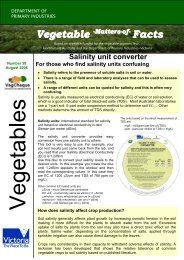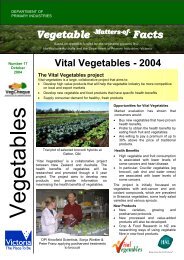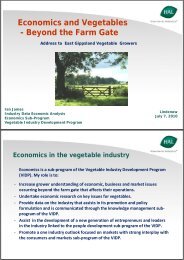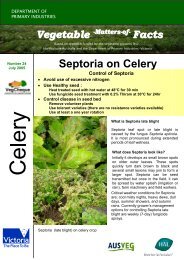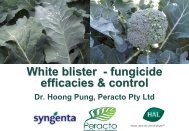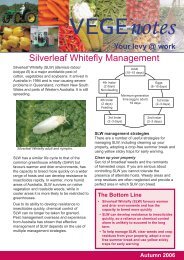Developing strategies to stimulate local consumption, export and ...
Developing strategies to stimulate local consumption, export and ...
Developing strategies to stimulate local consumption, export and ...
You also want an ePaper? Increase the reach of your titles
YUMPU automatically turns print PDFs into web optimized ePapers that Google loves.
2. Technical SummaryThe volume <strong>and</strong> variety of vegetables offered <strong>to</strong> Australian consumers have increaseddramatically over the last 20 years. However, the production of globe artichoke has remained<strong>to</strong> a large extent, almost static at between 500 <strong>and</strong> 1500 <strong>to</strong>nnes for decades. This situationreflects limited <strong>consumption</strong>, which can be attributed <strong>to</strong> unfamiliarity <strong>and</strong>/or difficulty in thepreparation <strong>and</strong> use of artichokes. This is despite the crop's culinary versatility, excellentnutritional value <strong>and</strong> potential <strong>export</strong> prospects. As well as pursuing opportunities <strong>to</strong>increase <strong>local</strong> <strong>consumption</strong>, there is also a need <strong>to</strong> address <strong>export</strong> <strong>and</strong> import replacemen<strong>to</strong>pportunities.Australia is currently a net importer of processed artichoke products <strong>to</strong> meet consumers'needs <strong>and</strong> <strong>to</strong> support a small processing industry that relies on canned artichokes for theproduction of anti-pas<strong>to</strong> products. Such products are marketed <strong>local</strong>ly <strong>and</strong>/or <strong>export</strong>ed at amuch higher price than the imported primary material. Furthermore, there is a certain lack ofvision in addressing the <strong>export</strong> opportunities <strong>and</strong> economic consequences of adopting newvalue adding <strong>and</strong> marketing <strong>strategies</strong> that are at the moment untapped by growers <strong>and</strong>processing firms.The aim of this project was <strong>to</strong>:a) Describe the current state of the globe artichoke industry <strong>and</strong> identify the barriersobstructing the increase in <strong>local</strong> <strong>consumption</strong> <strong>and</strong> <strong>export</strong> opportunities,b) Develop a pro<strong>to</strong>col for a frozen artichoke <strong>and</strong> other value-added products,c) Assess consumer's knowledge of fresh artichoke <strong>and</strong> acceptance of value-addedproducts <strong>and</strong>d) Document <strong>to</strong> the industry the achievable benefits of processing as a viable <strong>and</strong>complementary alternative <strong>to</strong> its present focus on the fresh market.The nature of this investigation dictated the use of four different research methodologies thatfocussed on: a) Collecting quantitative information <strong>and</strong> statistics by interviewing growers <strong>and</strong>food service opera<strong>to</strong>rs <strong>to</strong> ascertain their views on their respective industries <strong>and</strong> future vision;b) Experimenting with various anti-browning <strong>and</strong> processing treatments <strong>to</strong> test their efficacyin controlling enzymatic browning of fresh artichoke hearts destined for processing byfreezing; c) Determining consumers' acceptance of a processed products through panels ofassessors asked <strong>to</strong> indicate their level of preference for some sensory characteristics of theprocessed product <strong>and</strong> d) Documenting the economic benefits <strong>to</strong> the artichoke industry <strong>and</strong>reviewing its capacity <strong>to</strong> accommodate a <strong>local</strong> processing industry as a viable <strong>and</strong>complementary alternative <strong>to</strong> its present focus on the small <strong>and</strong> static fresh market.Our investigation showed that the artichoke industry in Australia is small by world st<strong>and</strong>ards<strong>and</strong> consists mainly of traditional family farm units clustered in Vic<strong>to</strong>ria where 90% of theannual crop (1300 <strong>to</strong>nnes) is produced. Production varies from year <strong>to</strong> year depending on thenumber of growers entering or exiting the industry. The bulk of the production is destined forthe <strong>local</strong> fresh market with sporadic <strong>export</strong>s <strong>to</strong> hospitality trades in the Asia/Pacific region.An estimated 700 <strong>to</strong>nnes of processed artichoke products are imported annually <strong>to</strong> satisfymainly the need of a <strong>local</strong> processing industry. The reliance on imported material is due <strong>to</strong> ashortage of <strong>local</strong> supply <strong>and</strong> the cheaper prices of overseas products. However, <strong>local</strong>processors have expressed interest in buying <strong>local</strong>ly, provided they can be guaranteed acontinuation of supply at prices comparable <strong>to</strong> the imported material.


